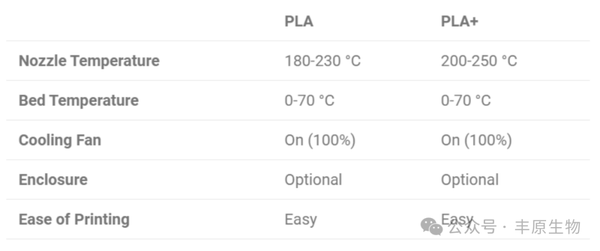Fengyuan Bio: The Main Differences Between PLA and PLA+ Materials
Manufacturers have sought to find a way to eliminate these weaknesses of PLA while maintaining all its positive qualities. One of the results of their efforts is the well-known PLA+. Getting to the crux of the matter, PLA+ is essentially a category that includes each filament company's upgraded PLA. Different companies call it PLA Plus, Pro, Extra, or Premium, but this just means an upgraded or enhanced version of their standard PLA. For the convenience of description in this article, we will refer to it as PLA+.
To manufacture PLA+, certain additives and modifiers are added during the synthesis stage of the manufacturing process to enhance the material's mechanical and material properties. This article will introduce the material characteristics of PLA+ that are superior to traditional PLA, as well as the optimal settings and printing techniques for both materials.

The following information is based on the data sheets of eSun (PLA, PLA+), UltiMaker (PLA, Tough PLA), and Polymaker (PolyTerra PLA, PolyMax PLA). More specific settings will depend on the brand and material.
Strength
In terms of strength, PLA falls within the medium range among FDM 3D printable plastics. Although it is not the weakest material, its strength is still noticeably lower than that of other materials such as PETG or ABS. PLA is also brittle, so it tends to break rather than deform under stress, making it less suitable for applications requiring flexibility. On the other hand, PLA+ is generally more flexible than PLA, and thus tends to bend before breaking when loaded. PLA+ typically exhibits higher tensile strength (the maximum stress a material can withstand while being stretched before breaking) and less brittleness, making it more resistant to cracking or breaking under pressure. PLA+ is also more impact-resistant than PLA.
Durability
Although PLA offers decent strength, it lacks in long-term durability. PLA is prone to wear, especially when exposed to mechanical stress, heat, or outdoor conditions. In contrast, PLA+ exhibits greater durability. It is more resistant to impact and wear, making it perform better in harsh environments.
Food Safety
Polylactic acid is considered food safe because it is derived from renewable resources such as corn starch.
Recycling

In terms of sustainability, polylactic acid is biodegradable and can be recycled. Currently, the best method for recycling PLA and PLA+ is to re-extrude failed prints, waste, and unused models back into usable filaments. In short, this process typically includes first cleaning the PLA waste to remove contaminants. Then, the cleaned PLA is shredded into small pieces using a plastic shredder. After that, the material is dried to remove moisture. The shredded PLA is then fed into a filament extruder, where it is heated and melted into a continuous filament. This newly extruded filament cools, is rewound, and is ready to be printed again.
【Copyright and Disclaimer】The above information is collected and organized by PlastMatch. The copyright belongs to the original author. This article is reprinted for the purpose of providing more information, and it does not imply that PlastMatch endorses the views expressed in the article or guarantees its accuracy. If there are any errors in the source attribution or if your legitimate rights have been infringed, please contact us, and we will promptly correct or remove the content. If other media, websites, or individuals use the aforementioned content, they must clearly indicate the original source and origin of the work and assume legal responsibility on their own.
Most Popular
-

List Released! Mexico Announces 50% Tariff On 1,371 China Product Categories
-

Nissan Cuts Production of New Leaf EV in Half Due to Battery Shortage
-

New Breakthrough in Domestic Adiponitrile! Observing the Rise of China's Nylon Industry Chain from Tianchen Qixiang's Production
-

Dow, Wanhua, Huntsman Intensively Raise Prices! Who Controls the Global MDI Prices?
-

Mexico officially imposes tariffs on 1,400 chinese products, with rates up to 50%






